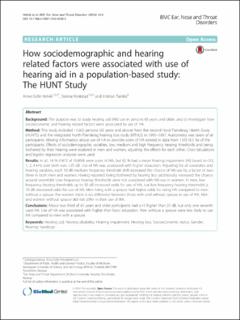| dc.contributor.author | Helvik, Anne-Sofie | |
| dc.contributor.author | Krokstad, Steinar | |
| dc.contributor.author | Tambs, Kristian | |
| dc.date.accessioned | 2020-03-26T10:11:05Z | |
| dc.date.available | 2020-03-26T10:11:05Z | |
| dc.date.created | 2016-07-20T12:42:33Z | |
| dc.date.issued | 2016 | |
| dc.identifier.citation | BMC Ear, Nose and Throat Disorders. 2016, 16 1-9. | en_US |
| dc.identifier.issn | 1472-6815 | |
| dc.identifier.uri | https://hdl.handle.net/11250/2648819 | |
| dc.description.abstract | Background:The purpose was to study hearing aid (HA) use in persons 65 years and older, and to investigate howsocioeconomic and hearing related factors were associated to use of HA.Method:This study included 11,602 persons (65 years and above) from the second Nord-Trøndelag Health Study(HUNT2) and the integrated North-Trøndelag hearing loss study (NTHLS) in 1995–1997. Audiometry was taken of allparticipants. Missing information about use of HA in possible users of HA existed in data from 1103 (9.5 %) of theparticipants. Effects of sociodemographic variables, low, medium and high frequency hearing thresholds and beingbothered by their hearing were explored in men and women, adjusting the effects for each other. Cross tabulationsand logistic regression analyses were used.Results:In all, 14 % (1472 of 10,499) were users of HA, but 62 % had a mean hearing impairment (HI) based on 0.5,1, 2, 4 kHz over both ears >25 dB. Use of HA was associated with higher education. Adjusting for all covariates andhearing variables, each 10 dB medium frequency threshold shift increased the chance of HA-use by a factor of two-three in both men and women. Having reported being bothered by hearing loss additionally increased the chancearound sevenfold. Low frequency hearing thresholds were not associated with HA-use in women. In men, lowfrequency hearing thresholds up to 50 dB increased odds for use of HA, but low frequency hearing thresholds≥70 dB decreased odds for use of HA. Men living with a spouse had higher odds for using HA compared to menwithout a spouse. For women there is no difference between those with and without spouse in use of HA. Menand women without spouse did not differ in their use of HA.Conclusions:About two third of 65 years and older participants had a HI higher than 25 dB, but only one seventhused HA. Use of HA was associated with higher than basic education. Men without a spouse were less likely to useHA compared to men with a spouse. | en_US |
| dc.language.iso | eng | en_US |
| dc.publisher | BMC | en_US |
| dc.rights | Navngivelse 4.0 Internasjonal | * |
| dc.rights.uri | http://creativecommons.org/licenses/by/4.0/deed.no | * |
| dc.title | How sociodemographic and hearing related factors were associated with use of hearing aid in a population-based study: The HUNT Study | en_US |
| dc.type | Peer reviewed | en_US |
| dc.type | Journal article | en_US |
| dc.description.version | publishedVersion | en_US |
| dc.source.pagenumber | 1-9 | en_US |
| dc.source.volume | 16 | en_US |
| dc.source.journal | BMC Ear, Nose and Throat Disorders | en_US |
| dc.identifier.doi | 10.1186/s12901-016-0028-2 | |
| dc.identifier.cristin | 1368758 | |
| dc.description.localcode | © 2016 The Author(s).Open AccessThis article is distributed under the terms of the Creative Commons Attribution 4.0International License (http://creativecommons.org/licenses/by/4.0/), which permits unrestricted use, distribution, andreproduction in any medium, provided you give appropriate credit to the original author(s) and the source, provide a link tothe Creative Commons license, and indicate if changes were made. The Creative Commons Public Domain Dedication waiver(http://creativecommons.org/publicdomain/zero/1.0/) applies to the data made available in this article, unless otherw | en_US |
| cristin.ispublished | true | |
| cristin.fulltext | original | |
| cristin.qualitycode | 1 | |

